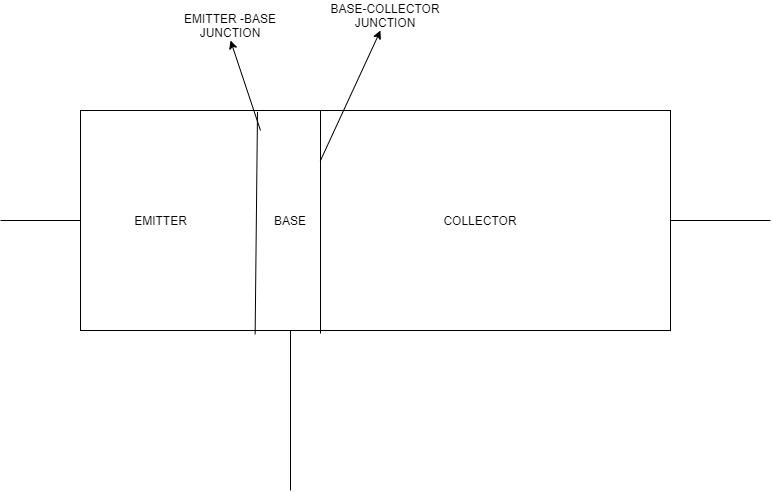
For a transistor which of the following statements are true:
A) Base, emitter and collector regions have similar size and doping concentrations.
B) The base region must be very thin and lightly doped.
C) The emitter-base junction is forward biased and base-collector junction is reverse biased.
D) Both the emitter-base junction as well as the base-collector junction are forward biased.
Answer
217.8k+ views
Hint: A transistor is a semiconductor device which is commonly used as a switch in electronic circuits and as an amplifier. It consists of three regions called Emitter, Base and Collector. The charge-carriers originate in the Emitter region and travel across the Base to the Collector region. There are 2 P-N junctions: Emitter-Base junction and Base-Collector junction. The voltage applied to one junction causes changes in the other junction and is helpful in controlling it.
Complete answer:

Let us study the validity of each of the four statements with explanations:
Statement – A: Base, emitter, and collector regions have similar size and doping concentrations.
The Emitter, Base and Collector regions have different sizes with varying concentrations.
The order of size of these regions are:
Base < Emitter < Collector
The order of the concentration of the regions are:
Base < Collector < Emitter
Hence, these regions are doped in a different way and their sizes are also, unsimilar.
Hence, this statement is wrong.
Statement – B: The base region must be very thin and lightly doped.
The base region is the thinnest region of the transistor and the electron concentration of this region, as a result, is the lowest among the three regions.
Hence, this statement is correct.
Statement – C: The emitter-base junction is forward biased and base-collector junction is reverse biased.
The emitter region has a high concentration of electrons. So, connecting them across the base will result in their movement to the base and then, the collector. To facilitate the movement of the charge carriers from emitter, the emitter-base junction is forward biased, and the base-collector junction is reverse biased so as to attract these charge carriers towards the collector region.
Hence, this statement is correct.
Statement – D: Both the emitter-base junction as well as the base-collector junction are forward biased.
If both the emitter-base and collector-base junction are forward biased, the charge carriers will not be able to cross the barrier across the base to move to the collector, thereby, decreasing or hindering the functionality of the transistor.
Hence, this statement is incorrect.
Out of the four statements, only statements B and C are correct.
Note: Some students might get confused in the statements whether they are referring to PNP junction transistor or NPN junction transistor. Irrespective of the type of the transistor, these statements hold true because, in the NPN transistor, the electrons are the main carriers and in the PNP transistor, the holes are the main carriers. So, in either cases, these statements are not ambiguous.
Complete answer:

Let us study the validity of each of the four statements with explanations:
Statement – A: Base, emitter, and collector regions have similar size and doping concentrations.
The Emitter, Base and Collector regions have different sizes with varying concentrations.
The order of size of these regions are:
Base < Emitter < Collector
The order of the concentration of the regions are:
Base < Collector < Emitter
Hence, these regions are doped in a different way and their sizes are also, unsimilar.
Hence, this statement is wrong.
Statement – B: The base region must be very thin and lightly doped.
The base region is the thinnest region of the transistor and the electron concentration of this region, as a result, is the lowest among the three regions.
Hence, this statement is correct.
Statement – C: The emitter-base junction is forward biased and base-collector junction is reverse biased.
The emitter region has a high concentration of electrons. So, connecting them across the base will result in their movement to the base and then, the collector. To facilitate the movement of the charge carriers from emitter, the emitter-base junction is forward biased, and the base-collector junction is reverse biased so as to attract these charge carriers towards the collector region.
Hence, this statement is correct.
Statement – D: Both the emitter-base junction as well as the base-collector junction are forward biased.
If both the emitter-base and collector-base junction are forward biased, the charge carriers will not be able to cross the barrier across the base to move to the collector, thereby, decreasing or hindering the functionality of the transistor.
Hence, this statement is incorrect.
Out of the four statements, only statements B and C are correct.
Note: Some students might get confused in the statements whether they are referring to PNP junction transistor or NPN junction transistor. Irrespective of the type of the transistor, these statements hold true because, in the NPN transistor, the electrons are the main carriers and in the PNP transistor, the holes are the main carriers. So, in either cases, these statements are not ambiguous.
Recently Updated Pages
Elastic Collision in Two Dimensions Explained Simply

Elastic Collisions in One Dimension Explained

Electric Field of Infinite Line Charge and Cylinders Explained

Electric Flux and Area Vector Explained Simply

Electric Field of a Charged Spherical Shell Explained

Electricity and Magnetism Explained: Key Concepts & Applications

Trending doubts
JEE Main 2026: Application Form Open, Exam Dates, Syllabus, Eligibility & Question Papers

Derivation of Equation of Trajectory Explained for Students

Hybridisation in Chemistry – Concept, Types & Applications

Understanding the Angle of Deviation in a Prism

Understanding Collisions: Types and Examples for Students

How to Convert a Galvanometer into an Ammeter or Voltmeter

Other Pages
JEE Advanced Marks vs Ranks 2025: Understanding Category-wise Qualifying Marks and Previous Year Cut-offs

Understanding Atomic Structure for Beginners

Ideal and Non-Ideal Solutions Explained for Class 12 Chemistry

Degree of Dissociation: Meaning, Formula, Calculation & Uses

Understanding Electromagnetic Waves and Their Importance

Understanding the Electric Field of a Uniformly Charged Ring




